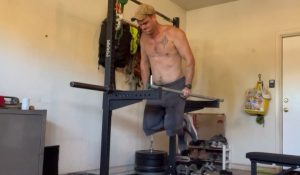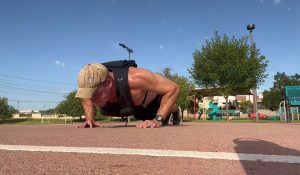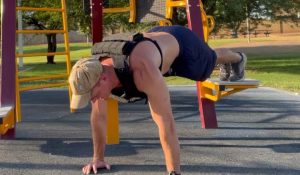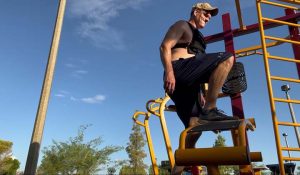I’ll be honest – the reason I love supersets so much is because they save time. But what about when you want to do more than just save time? What about when you want to also maximize targeting of a specific muscle, to maximize hypertrophy in a given session? This is where pre-exhaustion supersets shine.
If you’re an intermediate or advanced lifter that’s looking to maximize the stress on a particular muscle group to target a weakness or aesthetic weak point, then give the pre-exhaustion technique a try.
What is a pre-exhaustion superset?
A pre-exhaustion superset is a training technique that involves performing an isolation exercise before a compound exercise targeting the same muscle group. The goal is to “pre-exhaust” the target muscle group with an isolation exercise, which will then make the compound exercise more challenging, as the target muscle group will already be fatigued.
This style of training is a variation of agonist supersets, and it will necessitate that you complete fewer repetitions on the compound movement than you normally would. This is OK, and to be expected. The point is to bring a certain muscle to the brink of exhaustion and maximally fatigue all the muscle fibers in the target muscle group.
For example, if you want to target your chest, you might perform a set of dumbbell flyes (an isolation exercise) before moving on to bench press (a compound, multi-joint exercise). The flyes will fatigue your chest muscles, making the bench press more challenging and effective.
A practical example program
The pre-exhaustion technique is pretty powerful for creating excessive fatigue in the target muscle, which is a double-edged sword.
I recommend putting this technique into an existing “slot” in your program and only doing 2-3 supersets the first time you try it. After you’re
Even so, I personally wouldn’t recommend doing pre-fatigue sets for a certain muscle group more than once per week. Instead, opt to spend the rest of your week doing more typical training. An example of switching a hypertrophy day to a pre-exhaust superset workout would look like:
Original program (bench press slot):
| Monday | Thursday |
| Bench – 5×5, 3 min rest (strength focus) | Bench – 4×8, 2 min rest (hypertrophy focus) |
Revised program (to address an identified weakness in the triceps):
| Monday | Thursday |
| Bench – 5×5, 3 min rest (same as original) | EZ bar skullcrushers – AMRAP to 2-3 RIR, followed by Bench – 8 reps x4 rounds |
The lifter above would have to use a slightly lighter weight on his bench press on Thursdays. This is OK, as it’s only temporary. This lifter would likely see after a month or two that his stalled bench press would again begin to move. He would also enjoy some hard-earned muscle growth in the triceps.
Who should use pre-exhaustion training?

Pre-exhaustion is especially useful for intermediate and advanced lifters who are looking to target a specific area of weakness. For instance, if your squat progress has stalled because when you fatigue you dreaded “good morning squat”, then perhaps incorporating some pre-exhaustion sets for the quads will serve you well.
Similarly, if you’re looking to maximize the aesthetic appeal of your shoulders, but lack rear delt development, try pre-exhausting the rear delts with an isolation exercise before performing some type of ring row or neutral-grip pull-up.
One note – if you’re a beginner to lifting, you’ll likely experience the greatest benefits from simply mastering the basic exercises: squats, deadlifts, presses, rows, pull-ups, dips, etc. While you may still benefit from this technique, beginners need a more generalized and less targeted approach.
When to Use Pre-Exhaustion Supersets
Pre-exhaustion training is fantastic when in a hypertrophy or base-building phase. For instance, if you’re completing a 6-8 week training block targeting your quad development so that you can later maximize squat improvement in a strength training block, pre-exhaustion supersets will serve you well.
It is not recommended to use this technique much when you’re a few weeks out from an event or when you need to maximize performance. Since muscle building is a slow process, it’s unlikely that you’ll see immediate improvement from this technique.
The key is to utilize it to address a weakness, text your performance, reassess, and then address a new weakness.
Examples of Pre-Exhaustion Supersets
Here are some examples of pre-exhaustion supersets for various muscle groups by body part. This list is just to get you thinking – there are of course an infinite number of exercise combinations you could use once you grasp the concept:
Chest:
- Dumbbell flyes (or pec deck) + bench press or dumbbell press
- Cable crossovers + weighted push-ups
Back:
- Lat pulldowns + wide-grip pull-ups
- Strict pull-ups + deadlifts
Shoulders:
- Lying lateral raises + upright rows
- Standing rear-delt raises + inverted rows or neutral-grip pull-ups
Arms:
- Bicep curls + chin-ups (a personal favorite of mine!)
- EZ bar skull crushers + dips or weighted push-ups
Legs:
- Leg extensions + front squats (or safety bar squats, if you have access to a safety bar)
- Leg curls + stiff-legged deadlifts
What are you waiting for?
Pre-exhaustion supersets are an effective way to challenge your muscles and break through strength plateaus, strength-endurance plateaus, and address aesthetic weak points. By performing an isolation exercise before a compound lift targeting the same muscle group, you can pre-exhaust your muscles and make the compound exercise more challenging.
Try incorporating pre-exhaustion supersets into your training program strategically, and reap the rewards!





















